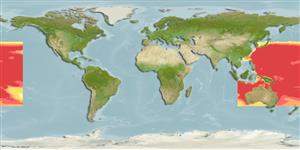Environment: milieu / climate zone / depth range / distribution range
Ecología
marino; rango de profundidad 0 - 600 m (Ref. 58302). Tropical; 43°N - 37°S, 105°E - 153°W
Indo-West Pacific (Ref. 559). Eastern Central Pacific (Ref. 58302).
Tamaño / Peso / Age
Maturity: Lm ? range ? - ? cm
Max length : 14.0 cm SL macho / no sexado; (Ref. 559)
Meso- (Ref. 7300, 75154) and epipelagic, associated with island slopes (Ref. 58302).
Life cycle and mating behavior
Maturities | Reproducción | Spawnings | Egg(s) | Fecundities | Larva
Masuda, H., K. Amaoka, C. Araga, T. Uyeno and T. Yoshino, 1984. The fishes of the Japanese Archipelago. Vol. 1. Tokai University Press, Tokyo, Japan. 437 p. (text). (Ref. 559)
IUCN Red List Status (Ref. 130435)
Threat to humans
Harmless
Human uses
Herramientas
Special reports
Download XML
Fuentes de Internet
Estimates based on models
Preferred temperature (Ref.
123201): 13.1 - 26.3, mean 19.8 °C (based on 297 cells).
Phylogenetic diversity index (Ref.
82804): PD
50 = 0.5001 [Uniqueness, from 0.5 = low to 2.0 = high].
Bayesian length-weight: a=0.01000 (0.00244 - 0.04107), b=3.04 (2.81 - 3.27), in cm total length, based on all LWR estimates for this body shape (Ref.
93245).
Nivel trófico (Ref.
69278): 3.3 ±0.4 se; based on size and trophs of closest relatives
Fishing Vulnerability (Ref.
59153): Low vulnerability (10 of 100).
